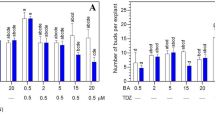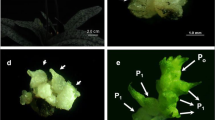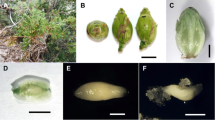Abstract
Platycladus orientalis is a widespread conifer, which is native in eastern Asia, and has recently attracted much attention due to its ornamental value for landscape and gardens. However, native P. orientalis populations have been in decline over the past century. Here, we established an in vitro propagation and cryopreservation system for P. orientalis via somatic embryogenesis (SE). Whole megagametophytes with four development stages (Early embryogeny: E1 and late embryogeny: L1, L2, and L3) of zygotic embryos from immature P. orientalis cones were used as initial explants and cultured on three different basal media such as initiation medium (IM), Litvay (LV), and Schenk and Hildebrandt (SH). Both the developmental stage of zygotic embryos and kind of basal medium had a significant effect on embryogenesis induction with IM (P < 0.001, respectively). The highest frequency of embryogenic callus induction was obtained in megagametophytes with zygotic embryos at L2 stage, which ranged as high as 30%. The maturation medium containing IM basal salts, vitamins and amino acids, 15 g l−1 abscisic acid (ABA), 50 g l−1 maltose, and 100 g l−1 polyethylene glycol 4000 (PEG) was found to be the suitable medium for production of somatic embryos. The frequency of somatic embryo formation from both non-cryopreserved and cryopreserved cell lines was also tested. There were no statistical differences on the production of somatic embryos between non-cryopreserved and cryopreserved cells (P = 0.523). Genetic fidelity of the plantlets regenerated from non-cryopreserved and cryopreserved embryogenic cell lines was assessed by both random amplified polymorphic DNA (RAPD) and inter simple sequence repeat (ISSR) analysis. There was no genetic instability in the regenerated plantlets from cryopreserved embryogenic cell lines. Both the SE protocol and cryopreservation protocols described here have the potential to contribute the conservation and clonal propagation of P. orientalis germplasm.








Similar content being viewed by others
Change history
22 September 2017
In the original publication, the concentration of abscisic acid mentioned in the Abstract and in the Materials and Methods was incorrect. It should have read 15 mg l−1.
Abbreviations
- ABA:
-
Abscisic acid
- AC:
-
Activated carbon
- BA:
-
Benzylamino purine
- IM:
-
Initiation medium
- MIM:
-
Maturation medium
- GIM:
-
Germination medium
- PGR:
-
Plant growth regulator
- 2,4-D:
-
2,4-Dichlorophenoxyacetic acid
- RAPD:
-
Random amplified polymorphic DNA
- ISSR:
-
Inter simple sequence repeat
- CP:
-
Cryoprotectant
References
Ahn CH, Kim YS, Lim S, Yi JS, Choi YE (2011) Random amplified polymorphic DNA (RAPD) analysis and RAPD-derived sequence characterized amplified regions (SCAR) marker development to identify Chinese and Korean ginseng. J Med Plants Res 5:4487–4492
Ahn CH, Tull R, Montello PM, Merkle SA (2017) A clonal propagation system for Atlantic white cedar (Chamaecyparis thyoides) via somatic embryogenesis without the use of plant growth regulators. Plant Cell Tissue Organ Cult 130:91–101
Arakawa T, Carpenter JF, Kita YA, Crowe JH (1990) The basis for toxicity of certain cryoprotectants: a hypothesis. Cryobiology 27:401–415
Aronen TS, Krajnakova J, Häggman HM, Ryynänen LA (1999) Genetic fidelity of cryopreserved embryogenic cultures of open-pollinated Abies cephalonica. Plant Sci 142:163–172
Aronen T, Pehkonen T, Ryynänen L (2009) Enhancement of somatic embryogenesis from immature zygotic embryos of Pinus sylvestris. Scand J For Res 24:372–383
Barberini S, Danti R, Lambardi M (2016) Somatic plant regeneration from selected common cypress (Cupressus sempervirens L.) clones resistant to the bark canker disease. Plant Cell Tissue Organ Cult 124:393–403
Bomal C, Tremblay FM (2000) Dried cryopreserved somatic embryos of two Picea species provide suitable material for direct plantlet regeneration and germplasm storage. Ann Bot 86:177–183
Cyr DR, Lazaroff WR, Grimes SMA, Quan G, Bethune TD, Dunstan DI, Roberts DR (1994) Cryopreservation of interior spruce (Picea glauca engelmanni complex) embryogenic cultures. Plant Cell Rep 13:574–577
De Verno LL, Park YS, Bonga JM, Barret JD (1999) Somaclonal variation in cryopreserved embryogenic clones of white spruce [Picea glauca (Moench) Voss.]. Plant Cell Rep 18:948–953
Debnath SC (2009) Development of ISSR markers for genetic diversity studies in Vaccinium angustifolium. Nord J Bot 27:141–148
Dussert S, Mauro MC, Engelmann F (1992) Cryopreservation of grape embryogenic cell suspensions 2: influence of post-thaw conditions and application to different strains. Cryo-letters 13:15–22
Engelmann F (1992) Effects of freezing in liquid nitrogen on the properties of a soybean (Glycine max L. var. acme) callus strain used as a bioassay for cytokinin activity. Cryo-letters 13:331–336
Gandhi SG, Mahajan V, Bedi YS (2015) Changing trends in biotechnology of secondary metabolism in medicinal and aromatic plants. Planta 241:303–317
Gupta PK, Durzan DJ (1985) Shoot multiplication from mature trees of Douglas-fir (Pseudotsuga menziesii) and sugar pine (Pinus lambertiana). Plant Cell Rep 4:177–179
Hakman I, Fowke LC, von Arnold S, Eriksson T (1985) The development of somatic embryos in tissue cultures initiated from immature embryos of Picea abies (Norway Spruce). Plant Sci 38:53–59
Helmersson A, von Arnold S (2009) Embryogenic cell lines of Juniperus communis; easy establishment and embryo maturation, limited germination. Plant Cell Tissue Organ Cult 96:211–217
Hirano T, Godo T, Mii M, Ishikawa K (2005) Cryopreservation of immature seeds of Bletilla striata by vitrification. Plant Cell Rep 23:534–539
Hu R, Sun Y, Wu B, Duan H, Zheng H, Hu D, Lim H, Tong Z, Xu J, Li Y (2017) Somatic embryogenesis of immature Cunninghamia lanceolata (Lamb.) Hook zygotic embryos. Sci Rep 7:56
Kim CS, Suh WS, Choi SU, Kim KH, Lee KR (2014) Two new diterpenoids from Thuja orientalis and their cytotoxicity. Bull Korean Chem Soc 35:2855–2858
Klimaszewska K, Noceda C, Pelletier G, Label P, Rodriguez R, Lelu-Walter M (2009) Biological characterization of young and aged embryogenic cultures of Pinus pinaster (Ait.). In Vitro Cell Dev Biol-Plant 45:20–33
Krajňáková J, Sutela S, Aronen T, Gömöry D, Vianello A, Häggman H (2011) Long-term cryopreservation of Greek fir embryogenic cell lines: recovery, maturation and genetic fidelity. Cryobiology 63:17–26
Lambardi M, Harry IS, Menabeni D, Thorpe TA (1995) Organogenesis and somatic embryogenesis in Cupressus sempervirens. Plant Cell Tiss Org Cult 40:179–182
Lambardi M, Lachance D, Séguin A, Charest PJ (1998) Evaluation of microprojectile-mediated DNA delivery and reporter genes for genetic transformation of the Mediterranean cypress (Cupressus sempervirens L.). Plant Cell Rep 18 (3–4):198–202
LePage BA (2003) A new species of Thuja (Cupressaceae) from the late Cretaceous of Alaska: implications of being evergreen in a polar environment. Am J Bot 90:167–174
Litvay JD, Verma DC, Johnson MA (1985) Influence of loblolly pine (Pinus taeda L.). Culture medium and its components on growth and somatic embryogenesis of the wild carrot (Daucus carota L.). Plant Cell Rep 4:325–328
Marum L, Rocheta M, Maroco J, Oliveira MM, Miquel C (2009) Analysis of genetic stability at SSR loci during somatic embryogenesis in maritime pine (Pinus pinaster). Plant Cell Rep 28:673–682
Maruyama E, Tanaka T, Hosoi Y, Ishii K, Morohoshi N (2000) Embryogenic cell culture, protoplast regeneration, cryopreservation, biolistic gene transfer and plant regeneration in Japanese cedar (Cryptomeria japonica D. Don). Plant Biotechnol 17:281–296
Maruyama E, Hosoi Y, Ishii K (2002) Somatic embryogenesis in Sawara cypress (Chamaecyparis pisifera Sieb. et Zucc.) for stable and efficient plant regeneration, propagation and protoplast culture. J For Res 7:23–34
Maruyama E, Ishii K, Hosoi Y (2005) Efficient plant regeneration of Hinoki cypress (Chamaecyparis obtusa) via somatic embryogenesis. J For Res 10:73–77
Murashige T, Skoog F (1962) A revised medium for rapid growth and bioassays with tobacco tissue cultures. Physiol Plant 15:472–497
Nairn BJ (1992) Commercial micropropagation of radiate pine. In: Ahuja MR (ed) Micropropagation of woody plants. Kluwer, Dordrecht, pp 383–394
Panis B, Lambardi M (2005) Status of cryopreservation technologies in plants (crops and forest trees). In: The role of biotechnology for the characterization and conservation of crop, forest, animal and fishery genetic resources in developing countries. FAO, Turin, pp 43–54
Quoirin M, Lepoivre P (1977) Improved media for in vitro culture of Prunus sp. Acta Hortic 78:437–442
Ramarosandratana A, Harvengt L, Bouvet A, Calvayrac R, Pâques M (2001) Effects of carbohydrate source, polyethylene glycol and gellan gum concentration on embryonal suspensor mass (ESM) proliferation and maturation of maritime pine somatic embryos. In Vitro Cell Dev Biol-Plant 37:29–34
Salaj T, Matušíková I, Swennen R, Panis B, Salaj J (2012) Long-term maintenance of Pinus nigra embryogenic cultures through cryopreservation. Acta Physiol Plant 34:227–233
Sallandrouze A, Faurobert M, El Maataoui M, Espagnac H (1999) Two-dimensional electrophoretic analysis of proteins associated with somatic embryogenesis development in Cupressus sempervirens L. Electrophoresis 20(4–5):1109–1119
Schenk RU, Hildebrandt AC (1972) Medium and techniques for induction and growth of monocotyledonous and dicotyledonous plant cell cultures. Can J Bot 50:199–204
Shapiro SS, Wilk MB (1965) An analysis of variance test for normality (complete samples). Biometrika 52:591–611
Smith DR (1996) Growth Medium. U.S. Patent No. 5,565,355
Taniguchi T, Kurita M, Itahana N, Kondo T (2004) Somatic embryogenesis and plant regeneration from immature zygotic embryos of Hinoki cypress (Chamaecyparis obtusa Sieb. et Zucc.). Plant Cell Rep 23:26–31
Tukey JW (1953) Some selected quick and easy methods of statistical analysis. Trans N Y Acad Sci 16:88–97
von Arnold S, Eriksson T (1981) In vitro studies of adventitious shoot formation in Pinus contorta. Can J Bot 59:870–874
Zhang NN, Park DK, Park HJ (2013) Hair growth-promoting activity of hot water extract of Thuja orientalis. BMC Complement Altern Med 13:9
Zhu L, Lou A (2013) Old-growth Platycladus orientalis as a resource for reproductive capacity and genetic diversity. PLoS ONE 8:e56489. Doi:10.1371/journal.pone.0056489
Acknowledgements
This work was financially supported by grants from the Post-Genome Multi-Ministry Genome Project (S111414L070110), and a 2014 research grant from Kangwon National University (C1010841-01-01).
Author information
Authors and Affiliations
Contributions
YEC designed all experiments and wrote drafts of the manuscript. CHA conducted the experiments and data analysis, took photos and wrote the manuscript.
Corresponding author
Ethics declarations
Conflict of interest
The authors declare no conflict of interest.
Additional information
Communicated by Qiao-Chun Wang.
An erratum to this article is available at https://doi.org/10.1007/s11240-017-1307-3.
Rights and permissions
About this article
Cite this article
Ahn, CH., Choi, YE. In vitro clonal propagation and stable cryopreservation system for Platycladus orientalis via somatic embryogenesis. Plant Cell Tiss Organ Cult 131, 513–523 (2017). https://doi.org/10.1007/s11240-017-1301-9
Received:
Accepted:
Published:
Issue Date:
DOI: https://doi.org/10.1007/s11240-017-1301-9




